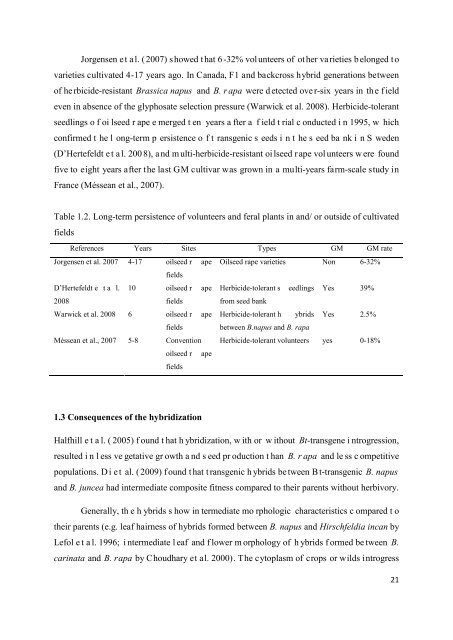UNIVERSITE DE BOURGOGNE THÈSE Yongbo LIU - Université de ...
UNIVERSITE DE BOURGOGNE THÈSE Yongbo LIU - Université de ...
UNIVERSITE DE BOURGOGNE THÈSE Yongbo LIU - Université de ...
You also want an ePaper? Increase the reach of your titles
YUMPU automatically turns print PDFs into web optimized ePapers that Google loves.
Jorgensen et al. (2007) showed that 6-32% volunteers of other varieties b elonged to<br />
varieties cultivated 4-17 years ago. In Canada, F1 and backcross hybrid generations between<br />
of he rbici<strong>de</strong>-resistant Brassica napus and B. r apa were d etected ove r-six years in th e field<br />
even in absence of the glyphosate selection pressure (Warwick et al. 2008). Herbici<strong>de</strong>-tolerant<br />
seedlings o f oi lseed r ape e merged t en years a fter a f ield t rial c onducted i n 1995, w hich<br />
confirmed t he l ong-term p ersistence o f t ransgenic s eeds i n t he s eed ba nk i n S we<strong>de</strong>n<br />
(D’Hertefeldt e t a l. 200 8), a nd m ulti-herbici<strong>de</strong>-resistant oi lseed r ape vol unteers w ere found<br />
five to eight years after the last GM cultivar was grown in a multi-years farm-scale study in<br />
France (Méssean et al., 2007).<br />
Table 1.2. Long-term persistence of volunteers and feral plants in and/ or outsi<strong>de</strong> of cultivated<br />
fields<br />
References Years Sites Types GM GM rate<br />
Jorgensen et al. 2007 4-17 oilseed r<br />
fields<br />
ape Oilseed rape varieties Non 6-32%<br />
D’Hertefeldt e t a l. 10 oilseed r ape Herbici<strong>de</strong>-tolerant s eedlings Yes 39%<br />
2008<br />
fields from seed bank<br />
Warwick et al. 2008 6 oilseed r ape Herbici<strong>de</strong>-tolerant h ybrids Yes 2.5%<br />
fields between B.napus and B. rapa<br />
Méssean et al., 2007 5-8 Convention Herbici<strong>de</strong>-tolerant volunteers yes 0-18%<br />
oilseed r<br />
fields<br />
ape<br />
1.3 Consequences of the hybridization<br />
Halfhill e t a l. ( 2005) f ound t hat h ybridization, w ith or w ithout Bt-transgene i ntrogression,<br />
resulted i n l ess ve getative gr owth a nd s eed pr oduction t han B. r apa and le ss c ompetitive<br />
populations. D i e t al. ( 2009) f ound t hat t ransgenic h ybrids be tween Bt-transgenic B. napus<br />
and B. juncea had intermediate composite fitness compared to their parents without herbivory.<br />
Generally, th e h ybrids s how in termediate mo rphologic characteristics c ompared t o<br />
their parents (e.g. leaf hairness of hybrids formed between B. napus and Hirschfeldia incan by<br />
Lefol e t a l. 1996; i ntermediate l eaf and f lower m orphology of h ybrids f ormed be tween B.<br />
carinata and B. rapa by Choudhary et al. 2000). The cytoplasm of crops or wilds introgress<br />
21
















